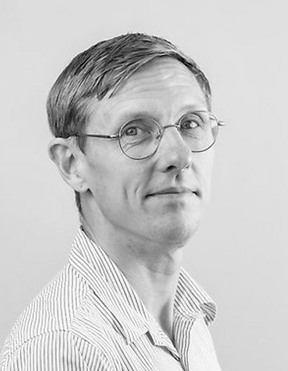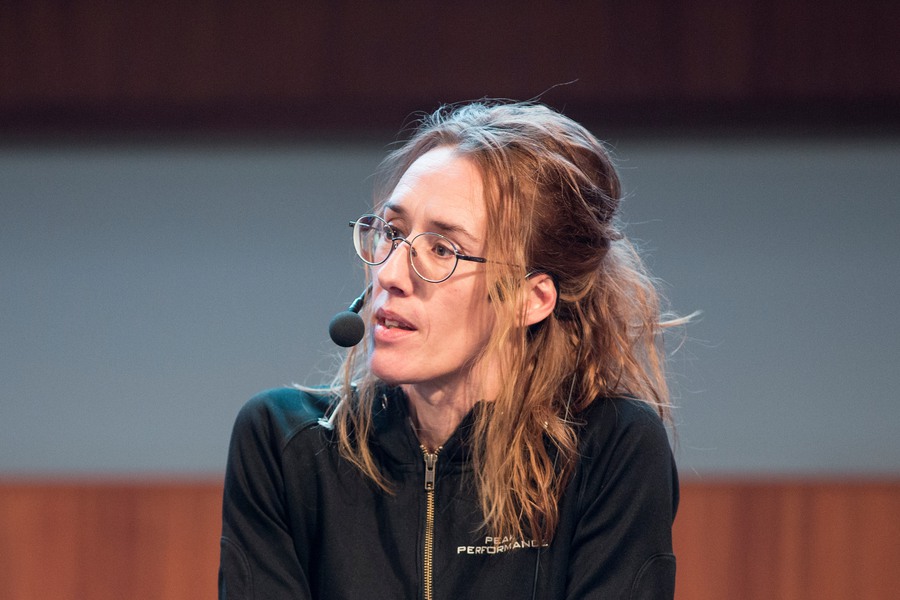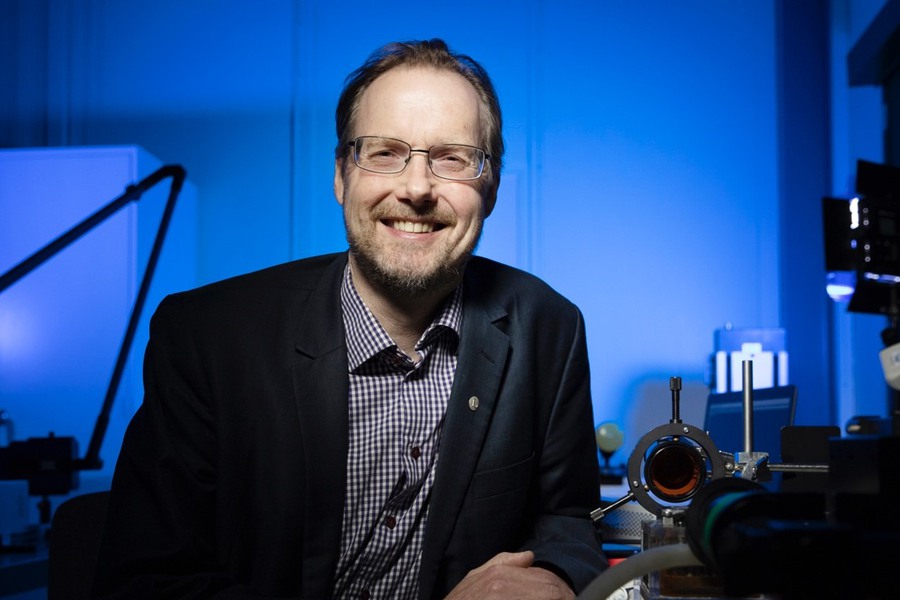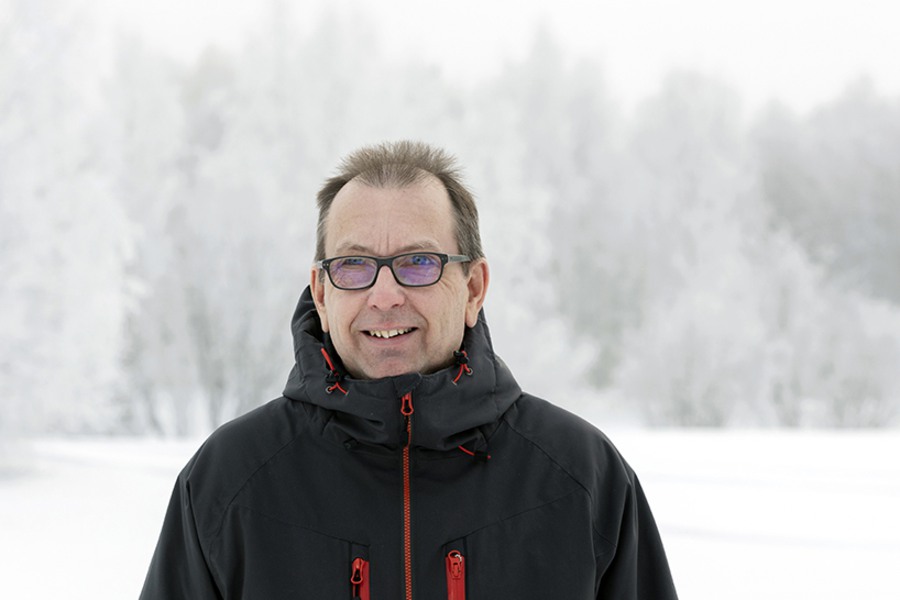Meet our researchers
We have a number of skilled researchers who use their research to drive SUN forward.

Joel Andersson
Beneath the Surface: Exploring the Geological Wonders of Mineral Deposits
Joel Andersson, Associate Senior Lecturer and the co-director of SUN Research School.
Tell us about yourself!
“I am a dedicated geologist from the northern reaches of Sweden, with a penchant for adventure and a father to two children. My sporting passions include sport climbing and swimming. I earned my PhD from Luleå University of Technology (LTU), where my research explored the connections between geological structures and iron deposits in the northern Norrbotten region. Currently, I am a co-supervisor for two PhD students and predominantly teach courses on basic geology and geoscience.”
What are you currently researching?
“I'm doing research in a Horizon Europe project that delves into the enrichment processes of lithium in the bedrock within the Varuträsk area, near Skellefteå, Västerbotten. This project aims to uncover the origin of lithium, its transportation mechanisms within the crust, and how it becomes concentrated in the locations where we currently find it. Additionally, through my supervision of PhD students, I'm involved in investigating the geology of iron, and copper-cobalt deposits in Norrbotten and I am also involved in the postdoc SUN-project Viscaria Cu-Co Spacetime.”
How did you end up doing research in your field?
“My journey began as a structural geologist with LKAB in the Malmberget iron mine, located in Gällivare. My fascination with understanding ore formation and conducting regional-scale studies grew. As LKAB's liaison for a research project at LTU, we crafted the research questions for my eventual PhD project. This lead me back to academia dedicating myself to research.”
What is the most exciting discovery/result you have made/achieved as a researcher?
“A landmark discovery in my research has been identifying the significance of geological structures in the formation of iron oxide-apatite deposits in northern Norrbotten. Alongside my colleagues, we dated brittle structures coinciding in age (within uncertainty margins) with the iron ores and understood subsequent deformation phases, connecting them to an ancient mountain building event that started around 1900 million years ago.”
How does your research play a role within SUN?
“My work provides a geological perspective on Sweden's mineral resources, which are crucial for transitioning to sustainable, fossil-free energy and transport sectors. Geological insights serve as the cornerstone for locating and sustainably extracting these mineral deposits.”
What do you want to achieve during your research career?
“My research aspirations are grounded in my passion for geology rather than a pursuit of specific milestones. I am deeply appreciative of the opportunity to contribute to our scientific legacy. I aspire for my work to bolster Sweden and Europe's self-sufficiency in metal resources.”
What is the most fun/most challenging thing about being part of SUN?
“The strength of SUN lies in its interdisciplinary approach towards tackling complex questions related to natural resources. This collaborative environment is both exhilarating and challenging.”
Why do you think SUN is important?
“SUN's interdisciplinary nature sets it apart, underscoring its significance. It harbors the potential to significantly contribute to a sustainable societal transition, which involves the careful management of water, forests, and minerals, while addressing and mitigating the inherent conflicts of such endeavors.”

Maria Pettersson
“I would like to see a development towards a balanced use of our natural resources'
Maria Petterson, Professor of Law, is part of the SUN steering group.
Tell us a bit about yourself!
“I was born and mainly raised in Luleå. I have a large family and enjoy being close to nature and have never had any plans to move away permanently. Besides exercise (which is one of my biggest interests), I enjoy reading books and spending time in the forest.”
What are you currently researching?
“Right now there is a lot of focus on the role of environmental assessment, not least in connection with the large establishments planned in northern Sweden. Otherwise, I'm involved in legal conditions for, for example, the use of different types of waste and substances, as well as issues of land use and climate adaptation in the Arctic.”
How did you come to do research in your field?
“I was asked by the chair at the time if I wanted to become a doctoral student in environmental law. Since studies in general and issues related to the environment and the use of natural resources in particular interest me, I accepted.”
How does your research play a role in SUN?
“Environmental and natural resource law sets the framework for the activities that SUN focuses on (ore, wood and water) and is at the same time an important instrument for managing conflicting objectives related to the use of natural resources. It is therefore important to understand how the regulatory framework affects the conditions for these activities, and to explore how environmental assessment can and should be designed to constitute an effective policy instrument. The aim is to protect human health and the environment and to enable (sustainable) economic growth.”
What is the most exciting discovery and result you have made or produced as a researcher?
“The most enjoyable results are those that have an impact on society - when we "find" something that we think needs to change and decision-makers listen to it. The expansion of wind power in the 2000s is one such example. Our research uncovered a number of institutional barriers to such expansion that have since been addressed in both legislation and policy.”
What do you want to achieve in your research career?
“That's a difficult question. I don't really see it as a "career"... I would like to see a development towards a balanced use of our natural resources and if I can contribute to this, I am happy.”
What is the most fun and challenging part of being part of SUN?
“The most fun is that so many disciplines come together and exchange thoughts and ideas around a common theme. Both the graduate school and the seed projects, projects funded by seed money, show the potential of studying natural resources and society from multiple perspectives. Probably the most challenging thing is to understand each other's starting points.”
Why do you think SUN is important?
“The most fun is also the most important. There is a need for both subject-specific and inter- and multidisciplinary research to meet the challenges we face.”

Staffan Lundström
“I want to contribute to the development of society”
Staffan Lundström, Professor of Fluid Mechanics, is part of the SUN steering group.
Tell us a bit more about yourself!
“I grew up in Burträsk, Västerbotten and have since, due to studies and work, lived in various places in Sweden and ended up in Luleå in 2000. My free time is spent with my family, with some sports activities like running, canoeing and skiing and gardening.”
What are you researching right now?
“My subject is fluid mechanics, and scientific questions often concern flow in porous materials. I also find it very interesting to see how we in my subject can, together with other subject experts, contribute to solving different problems. It can be collaborations with relatively related subjects as we have had in a project on filtration of liquid droplets in face masks but also quite different subjects as when we research together with biologists on fish migration.”
How did you come to do research in your field?
“Basically, it was due to my choice of degree project and then I was asked to do a PhD at an institute, SICOMP (now RISE SICOMP) on manufacturing processes for composites. But it has not been a straight line until now. For example, I applied for and got a job outside academia after my licentiate degree. However, I got interested in research again after a longer trip around the US.”
How does your research play a role within SUN?
“It is two-fold. On the one hand, it comes in via hydropower, where I know a lot of the research and have an established network, especially in Sweden and the rest of Europe. On the other hand, there are often various fluid mechanics issues in both industrial and natural processes linked to all areas of SUN.”
What is the most exciting discovery and result you have made or produced as a researcher?
“It is also two-part. Firstly, it is fun when I see that industry/society uses our research results. On the other hand, it is fun when unexpected fluid mechanics phenomena arise, often during experiments, which we can then explain with theory and models.”
What do you want to achieve during your research career?
“I want to contribute to the development of society.”
What is the most fun and challenging part of being part of SUN?
“It is fun that we from quite different disciplines come together to help solve big problems.”
Why do you think SUN is important?
“Using natural resources in a way that is acceptable to most people is very challenging. I believe that we as a university can contribute to this challenge, especially since we are becoming a mature university with many strong researchers and are geographically located in an area with large natural resources, which provides a fundamental understanding of the complexity of the challenges we face.”

Patrik Söderholm
"I hope that my research can be a piece of the puzzle in the realization of the green transition."
Patrik Söderholm, Professor of Economics, is Deputy Scientific Director of SUN.
Tell us a bit about yourself!
“I come from Luleå and live here with my wife Kristina and twins Ella and Bodil (now 18 years old). My roots are in Norrbotten, my mother came from Älvsbyn and my father from Seskarö. In 1988 I started studying economics at Luleå University of Technology, and I also studied economics at Umeå University. Since 2006 I am a professor of economics, but I have also done research at universities and institutes in Boston (MIT), Vienna (IIASA), and Leipzig (Helmholz-UFZ).”
What are you currently researching?
“I'm involved in a number of different research projects, most of which are related in various ways to the green transition of industry. The research includes how different climate and energy policy instruments affect the incentives for technological development and innovation, and how such instruments can be designed effectively. Together with legal experts and historians, I have, for example, studied the conditions for a more appropriate environmental assessment of industrial activities.”
How did you come to do research in your field?
“I have always had an interest in economic issues, and in the beginning I was mostly interested in macroeconomics. In the early 1990s, the opportunity was created to pursue doctoral studies in economics at Luleå University of Technology; the focus was on energy, natural resource and environmental economics and my 1997 thesis was on fuel choice and fuel substitution in European electricity production. Since then, my research has broadened in different directions; I have written a lot about waste and recycling over the years.”
How does your research play a role in SUN?
“SUN is about how the natural resource-based industry plays an important role in the climate transition and sustainable development. My research is about how this transition can be achieved, and in a way that can reconcile different goals, such as climate, competitiveness and regional development. The state - and various authorities at regional and local level - need to support this development in various ways, and it is important that various political instruments and legislation are designed in an appropriate way. An important target group for my research is political decision-makers and officials at authorities and public organizations.”
What is the most exciting discovery/result you have made/produced as a researcher?
“The most cited research I have conducted is on technological development, including learning-by-doing, related to renewable energy sources, mainly wind power. Among other things, this research has shed light on how the effects of technological development (so-called learning rates) can be measured empirically and how different policy instruments affect this development. In collaboration with researchers in entrepreneurship and innovation systems, I have also contributed to a better understanding of how different types of pilot and demonstration plants can promote sustainable technological development. These studies have resulted in important lessons both for policy and for the organization and governance of such facilities. Finally, together with other researchers, I have developed guidelines on how the environmental assessment of industry can be designed and implemented in a way that reconciles industrial competitiveness with tough environmental conditions. This research has direct relevance to the current debate on the potential shortcomings of Swedish environmental assessment.”
What do you want to achieve during your research career?
“An important goal is to have fun, that is, to find issues and research projects that you long to dig into every day. I think this is also when the best research comes out. Right now, I also hope that my research can be a piece of the puzzle in the realization of the green industrial transition that is now taking place, not least here in Norrbotten.”
What is the most fun/most challenging thing about being part of SUN?
“It is inspiring to learn from the experiences and knowledge of others, both other researchers but also the members of SUN's strategic council who represent both industry and government. It is also fun - but also challenging and difficult - to fully understand other perspectives and identify new groundbreaking research from them.”
Why do you think SUN is important?
“SUN is important because the area addresses a challenge that is both important and difficult: natural resources in the form of ore, forests and water are necessary for the transition to sustainable development, but also involve difficult trade-offs between different societal goals. This transition is not only about climate and industrial competitiveness, but also about links to other environmental objectives, social acceptance and regional development in general. It is therefore important to conduct research that contributes to increasing knowledge of these conflicting objectives and how they can be managed. SUN is investigating how different technical solutions can sometimes help to resolve conflicts of objectives and interests (for example, linked to land use). The research also deals with how the organization of society and its institutions (i.e. legislation, norms) affect the possibilities to realize the natural resource-based green transition and to manage the goal conflicts resulting from this transition.”
Updated:
